Night Vision Astronomy is the repurposing of night vision devices and technology for astronomical observing.
Using these devices lights up the sky and enables you to see much more than you would otherwise – either with the naked eye or with a telescope under comparable conditions. It can be utilized for both wide-field stargazing and deep sky viewing.
It can be hard to understand the equipment needed and techniques used for Night Vision Astronomy (NVA) though. In this article, we try to answer the main questions including the advantages and disadvantages over regular astronomy and what gear is required.
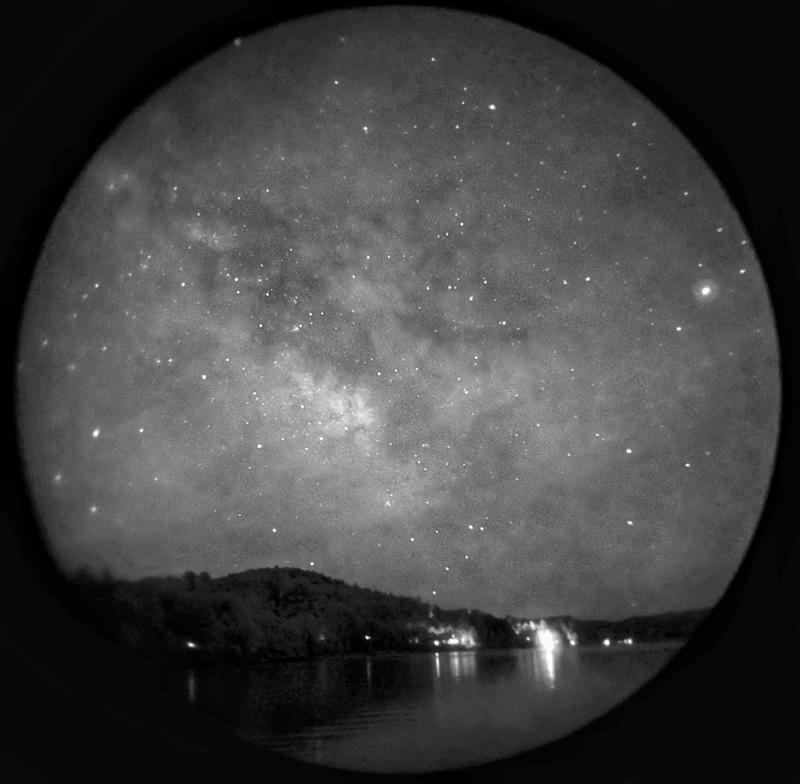
What is Night Vision?
Night Vision (NV) is a form of technology that allows you to see in the dark.
There are three main categories of night vision technology:
- Image Intensified Night Vision
- Digital Night Vision
- Thermal Night Vision
All of these convert a view so dark that it would be impossible to see much (or anything) and make it lighter and possible to see much more.
There are some key differences between these three categories.
Image Intensified Night Vision
Image intensifiers are tube-shaped components that amplify low levels of light into visible quantities.
This is what sits inside advanced night vision devices to enable them to see in low light. The device can then be in the form of goggles, binoculars or monoculars as these all act as housings for the image intensifier tube.
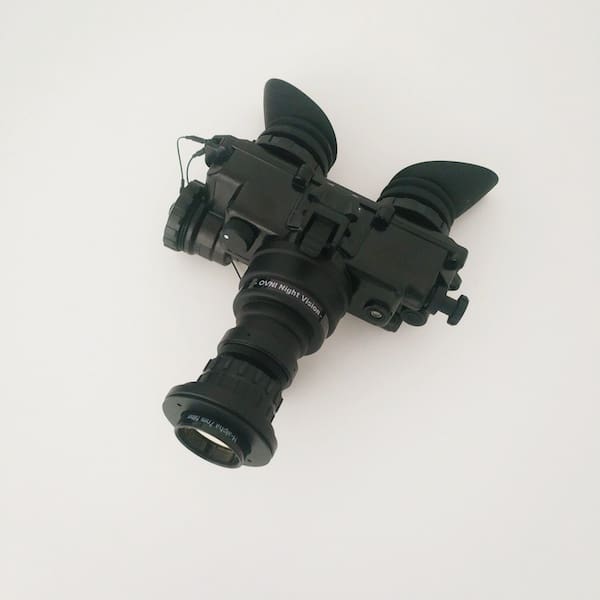
There are three different generations of image intensified night vision technology, with each generation becoming more effective and the third generation currently the most advanced.
There is a fair bit of complexity about this though so check out night vision devices and image intensifiers on Wikipedia if you want to go deep.
Digital Night Vision
There are also digital night vision devices that do not use image intensifiers. These are effectively digital cameras with CCD sensors where you are viewing the screen through an eyepiece.
Digital night vision devices are less effective than image-intensified devices but they are considerably cheaper and often easier to acquire as they are not utilizing military technology.
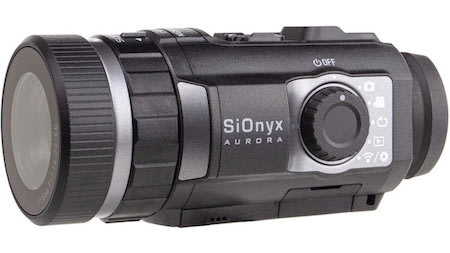
Thermal Night Vision
There are also thermal imaging devices that allow you to see heat but are not really relevant for our purposes here so we won’t delve into any further.
What is Night Vision Astronomy?
Night Vision Astronomy (NVA) is the use of this technology for observing the night sky and viewing astronomical objects.
There are two main ways to do this:
Through handheld night vision devices like night vision binoculars or a monocular
This is best for scanning the night sky and having wide-field images of the milky way, or viewing astronomical events like comets or meteor showers. You can also add filters and magnifiers to this to enhance the views – more on this later.
Here is a great short video from Galactic Hunters that shows these astronomers/astrophotographers getting their hands on a night vision device for the first time and recording the video with their smartphone just held up to the eyepiece:
Incorporating a night vision device as part of a telescope setup
This involves attaching the night vision binocular/monocular, or just an image intensifier tube, directly to a telescope to enhance the view. This is best for deep sky astronomy.
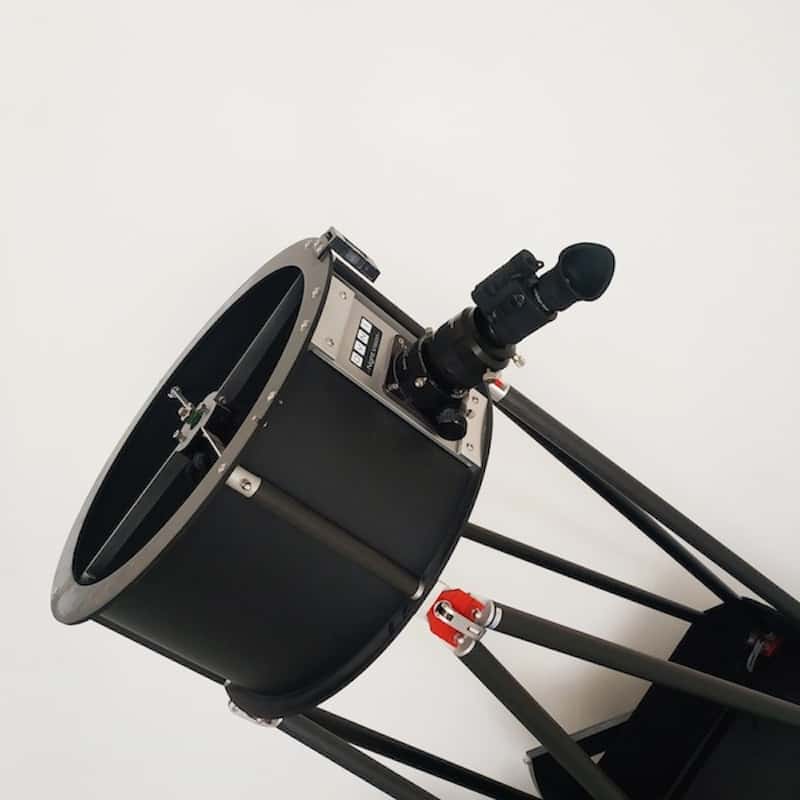
A key thing to note is that NV astronomers have been for the most part repurposing gear and technology that has been primarily designed for military use. However, there are now some producers of night vision devices specifically for astronomy (like the OVNI devices featured above).
Night Vision Astrophotography
Similarly, night vision technology can be utilized for astrophotography.
The most common way of doing this is by attaching a smartphone to a night vision binocular/monocular and imaging afocally (i.e. holding it over the eyepiece).
Here is an example image taken with an iPhone through a night vision device of the Milky Way:
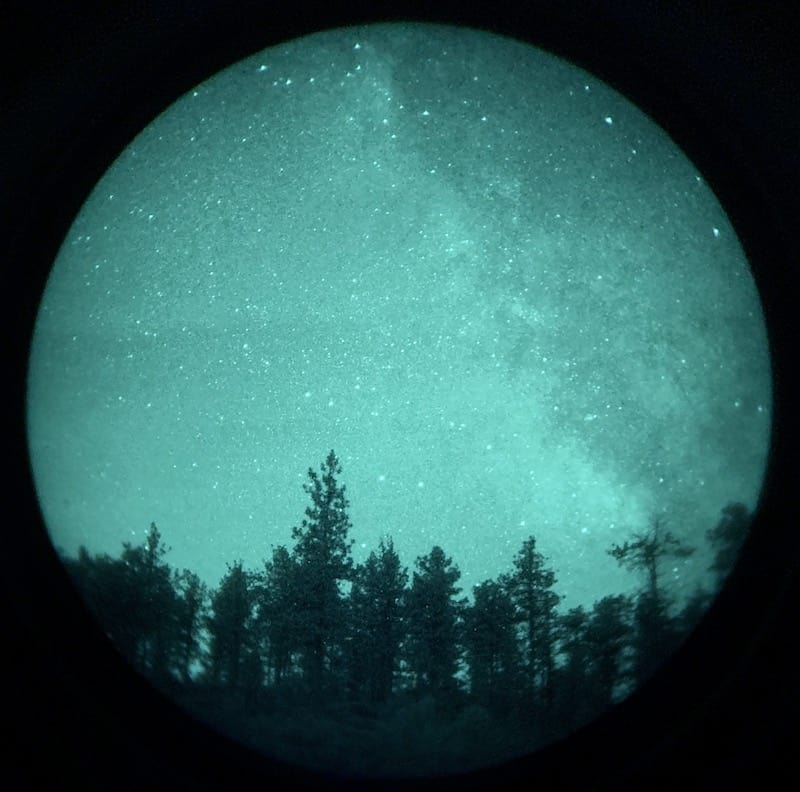
An example of deep sky astrophotography can be seen in this image of M101 Pinwheel Galaxy, taken with a night vision device, telescope and iPhone XR (Credit: GeezerGazer):
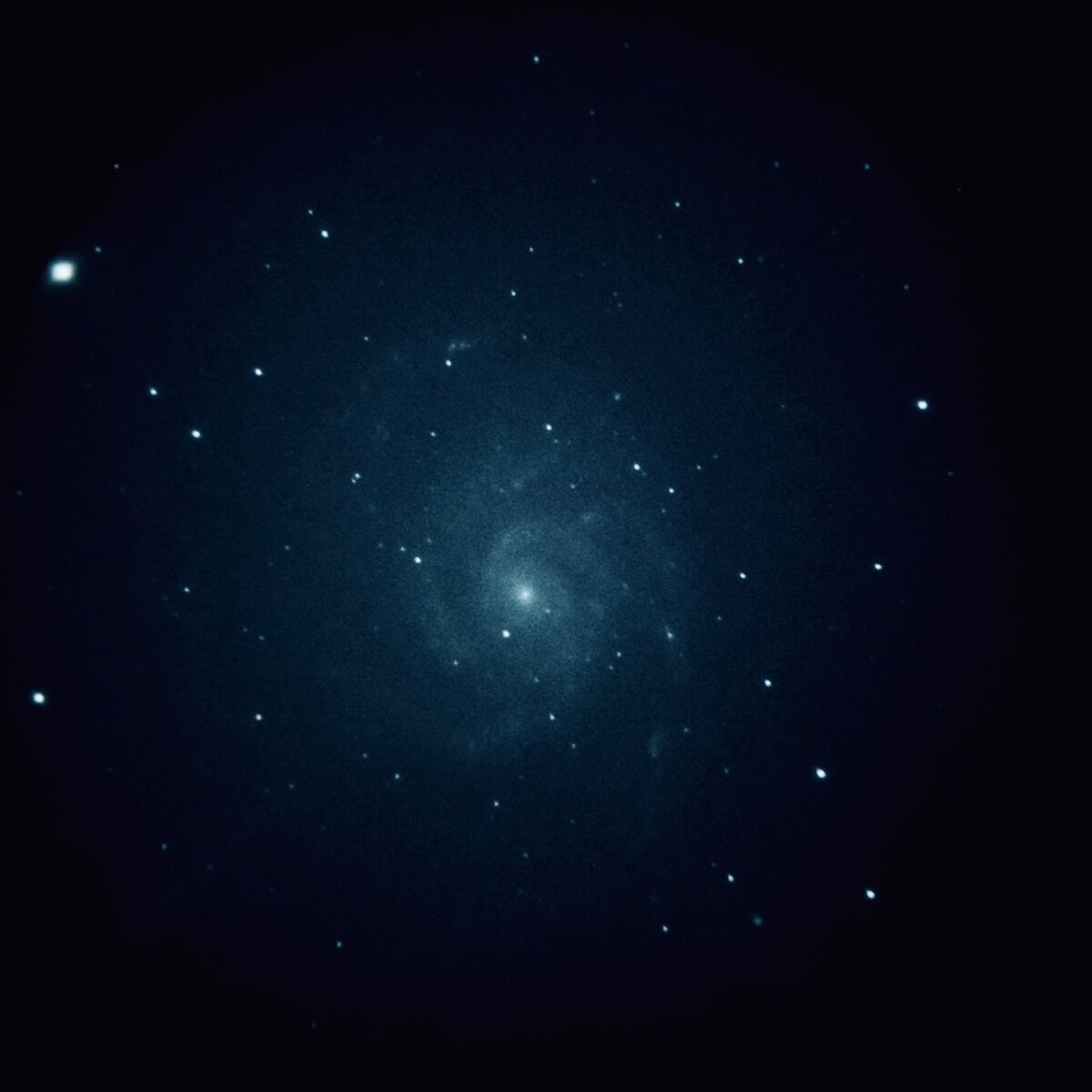
Advantages of Night Vision Astronomy & Astrophotography
“NV have delivered views that I never thought were even remotely possible before this technology became available.”
bobhen (Coudy Nights, 17 May 2020)
There are some distinct advantages to night vision astronomy over “regular” astronomy.
Regular astronomy, as you probably well know, involves viewing the night sky, usually with equipment like a telescope or binoculars.
However, for many, astronomical observing is particularly hampered by light pollution. This is the brightening of the night sky from artificial light produced by buildings, street lights and other sources from towns and cities.
Today, most people that reside in or near a town or city see very little in the way of stars or other objects when looking up to the night sky. This contrasts with the thousands of stars you might see in a dark sky site far from a center of population.
You are therefore left with the choice of either traveling out of town to dark sky sites – this can be too time-consuming and impractical for many – or you can buy ever more powerful equipment. This upgraded gear costs more and also gets inevitably larger and more cumbersome – another barrier to being able to quickly and easily view the night sky.
The advantages of night vision astronomy are then:
- Reduces impact of light pollution: NV astronomy offers a way of bypassing the light pollution problem. It brightens the skies so that you can step into your backyard, rooftop or balcony and observe objects in the night sky that would otherwise be extremely hard to see, either with the naked eye or with regular telescopes or astronomy binoculars.
- Can reduce cost and size of equipment: Adding the night vision device to a telescope setup can dramatically improve its effective aperture and viewing/imaging performance. Whilst the NV gear can be expensive (more on this below), utilizing it can mean that you can use much smaller, more portable, and cheaper telescopes and mounts.
- Improves ease-of-use: Night Vision devices can offer grab-and-go convenience so that you can pick them up and be out observing virtually immediately. Similarly, it can be much quicker to set up a lighter telescope and mount set up with an NV device, over a large heavy telescope. Many enthusiastic astronomers will have huge reflecting telescopes (some as big as a grown adult) which they may love, but they certainly aren’t ‘grab-and-go’ and aren’t for the vast majority of people who may love to look at the night sky but have nowhere, or no desire, to own and store such large and cumbersome equipment.
- Real-time viewing: You are able to observe astronomical objects in real-time which would not be possible otherwise. There is a related pursuit called Electronically Assisted Astronomy (EAA) where the image from a telescope is displayed on a laptop or similar device but at a delay and requiring power sources and cables.
- Faster astrophotography imaging: Imaging with a night vision astronomy setup allows you to capture images in realtime that would otherwise require long exposures of minutes, hours or even multiple nights. They also need processing afterward to bring out the detail. Night vision astrophotography can be done – and usually is – with a smartphone camera and is instant. It also cuts the extra cost and inconvenience of an additional camera as part of the setup.
“While it was easy to blow off a clear night after a long day at work because it’s a hassle to set up the dobsonian, I can grab my NV device, put on a filter, put my 3x afocal lens in a pocket and head out the door. I’ve done 10 minute observing sessions while taking out the garbage using NV, and seen more than I would have seen with the dob.”
Doug Culbertson (Cloudy Nights, 30 June 2016)
Disadvantages of Night Vision Astronomy & Astrophotography
If there are so many advantages then, how come it is not a more common practice?
There are a few reasons for this:
- Relatively high price: Night vision gear is expensive. You are looking in the thousands of dollars for a night vision device that you can use for astronomy. However with a deep sky setup you can have a much smaller and cheaper telescope to offset the cost of the NV device.
- Limited guidance and availability: It’s difficult to find good information on NVA techniques and gear. This is because NV gear is primarily sold for military and hunting use and adapting it for astronomy is a fairly niche endeavor. Therefore it can be hard to find good written guides online without navigating advanced forums. Also, whereas you can just email or call up your favorite outlet for astronomy gear and ask for advice on what is right for you, if you ask for advice on NVA gear you’re unlikely to get the same level of advice unless you happen to get extremely lucky with the individual that responds to you. In addition, 3rd generation image intensified night vision devices made in the US often cannot be exported outside the country as this would fall into arms trafficking restrictions.
- Not for lunar or planetary: NV is good for either generally stargazing with a handheld device or deep sky viewing through a telescope. It’s not good for planetary observation (they are effectively so bright that it requires heavy filtering to observe and this removes all the detail you’d want to see). It’s also completely unnecessary for lunar viewing/photography since the moon is also very bright and easy to use. Therefore if planetary or lunar observing are your thing, then NVA will not be for you.
- Color: What you see will usually either be in white or green. This is just how the NV technology works and you get to choose if you prefer white phosphorus or green phosphorus when buying your device. The colors of deep sky objects or the milky way will not come through in the way it would appear in a long exposure astrophotography image.
- Comfort: If you are using NV binoculars/monocular directly then you will be tilting your head up at an angle to view the sky. This will get uncomfortable after even a short while and therefore you’ll need to get yourself an astronomy chair or similar for long viewing sessions.
Therefore NVA is not without its drawbacks, but putting together pretty much any astronomy or astrophotography setup is challenging so it’s all about whether you think it’s worth it.
Without doubt there are many NVA evangelists, and for city dwellers it can offer an answer to the light pollution problem. However, it is a pursuit undertaken by relatively few at this time (and at any time in the past few years) and this is partly because of the cost and availability of gear.
Best Night Vision Devices for Astronomy
To undertake night vision astronomy you are going to have to get your hands on a night vision device (NVD).
These can be broadly rounded up into three categories:
- Dedicated Astronomy Night Vision Devices – devices specifically manufactured for astronomy
- Regular/Military Night Vision Devices – i.e. the repurposing of existing image-intensified NVDs for astronomy use
- Digital Night Vision Devices – non-image intensified devices that can be used for NVA
Let’s look at each in turn.
Dedicated Night Vision Devices for Astronomy
French company OVNI Night Vision is the first and only manufacturer and seller of night vision devices specifically for astronomy.
Released in 2019 & 2020, they offer two different NVDs – the OVNI-M & OVNI-B that house the same third-generation image intensifier tube.
Jonathan Kobs, Owner & Founder of OVNI says “At OVNI Night Vision, we develop GEN3 intensifier tubes with the best performance in the world – better than military tubes. For example, the best US military tubes for binocular use are around FOM2000, while we can provide them for our OVNI-B with FOM2600 and our best tube ever made reached FOM2700.”
Since they are made in France they do not fall under any US export restrictions and can be sold to individuals in Europe, Canada, Australia, New Zealand, and Japan, as well as the US.
OVNI-M (Monocular)
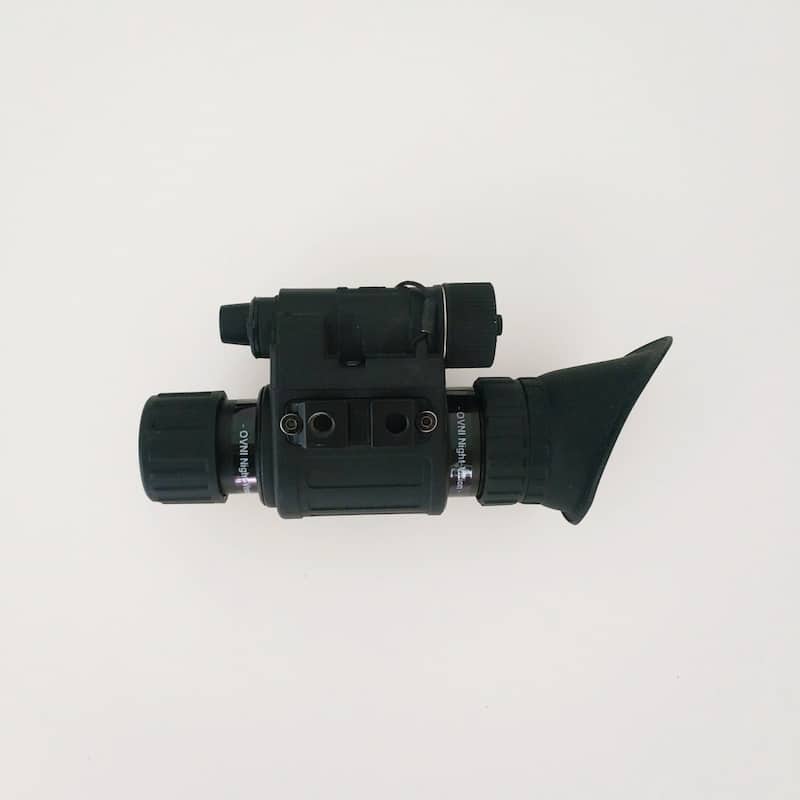
The OVNI-M is the monocular version of OVNI’s two devices.
It can be used handheld, with the possibility of using it with regular DSLR lenses. It can also be attached to a telescope in either afocal or prime focus.
It can be bought with the image intensifier at four different figures of merit, with each level increasing in cost.
This is the cheaper of the two devices owing to just the single eyepiece.
- Type: Monocular
- Lens interface: Afocal or prime
- Gain control: Manual
- Green/White Phosphor: White
See more on the OVNI-M here.
OVNI-B (Binoviewer)
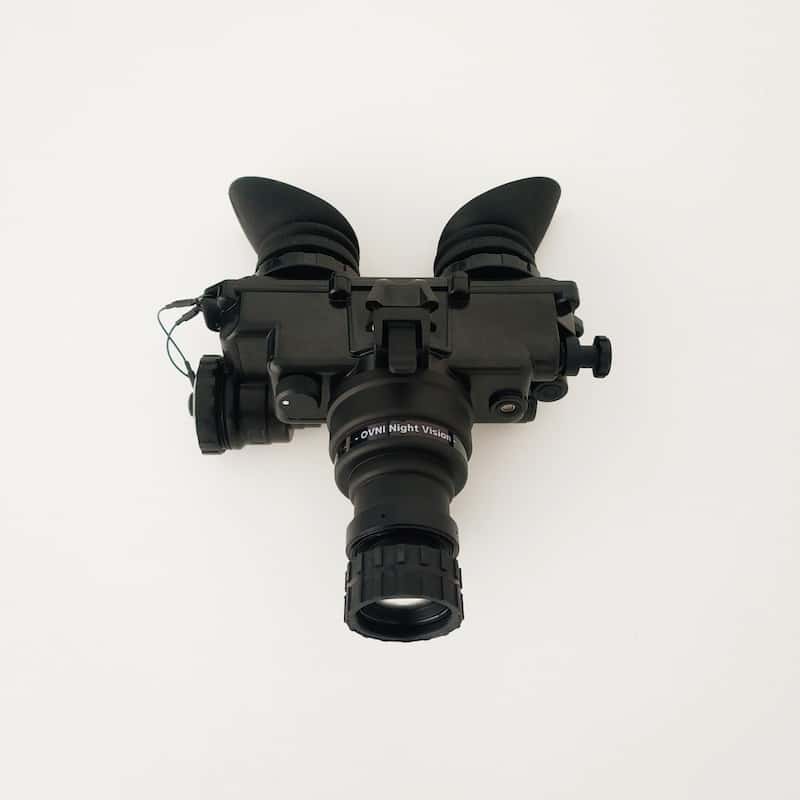
The OVNI-B is the binoviewer version of the OVNI’s two devices.
It houses the same image intensifier as the OVNI-M but adds a second eyepiece and so can be used with two eyes. This is a considerable advantage for handheld use and also adds a new dimension to use with a telescope where most would be used to looking through one eye.
The downside is that it does cost slightly more than the monocular version.
- Type: Monocular
- Lens interface: Afocal or prime
- Gain control: Manual
- Green/White Phosphor: White
You can read more about the OVNI-B here.
Regular/Military Night Vision Devices
With these, you will be getting hold of a “regular” night vision device that was primarily designed for military purposes and then using it for NV astronomy.
The most commonly used and recommended devices for astronomy in this category are the:
- PVS-7 goggles
- PVS-14 monocular
- MOD-3 monocular/binocular
These names refer to types of housing that can be manufactured and sold by different companies and have different image intensifiers inside, as well as other differences in specifications.
This can be quite confusing for a beginner looking to understand NVA as it is not simple to get a recommendation on a specific model. For instance, if you go to a seller of a MOD-3 then you might be given a choice of image intensifier tube as well as other customizations which matter for NVA.
Therefore any recommendation of these (or other) NVD housings will be based on those things that differentiate them, for example:
- Type: Monocular vs binocular vs goggles/binoviewer. With a monocular you see through only one eye. With a binocular you use two eyes and there should be two objective lenses (with some monoculars you can also combine two to turn them into binoculars). With goggles or a binoviewer you have just one objective lens with the image split between two eyepieces. Most would prefer looking through two eyes for handheld stargazing but most astronomers are probably comfortable with looking through a telescope with one eye. However, using two eyes this way can also offer a new experience.
- Focus: Afocal vs prime. Afocal means you are attaching the NVD to an eyepiece that is connected to the telescope. Prime means attaching straight onto the telescope without an eyepiece and having this flexibility is an advantage and offers different views.
- Lens interface: C-mount vs Standard Mount. If the device is C-mountable then it can be used prime, rather than just afocal. Having this option is a positive.
- Gain control: Manual vs automatic. Ideally you want manual gain control as this allows you to manually adjust the brightness to suit you.
- Viewing color: White Phosphor vs Green Phosphor. Most consider white phosphor sensor devices better for astronomy but green phosphor is usually cheaper and some do prefer it. The color of the phosphor tube is a preference issue, not a performance issue, and it’s a matter of taste.
- Autogating: This functionality protects the image intensifier if it is exposed to a bright light that could otherwise be damaging. Therefore this is good to have.
With regards to the image intensifier tube, this is the real factor in the performance of the night vision device, as the NVD is just a housing for the tube. The easiest way to determine the quality of the image intensifier is by the Figure of Merit (FOM) given – the higher the number the better it should be.
Note that Generation 3 devices made in the US cannot be exported as they fall under International Traffic in Arms Regulations (ITAR) restrictions.
Let’s look at each of these three NVD housings so we can pick out the differences:
Mod-3 Monocular/Binocular
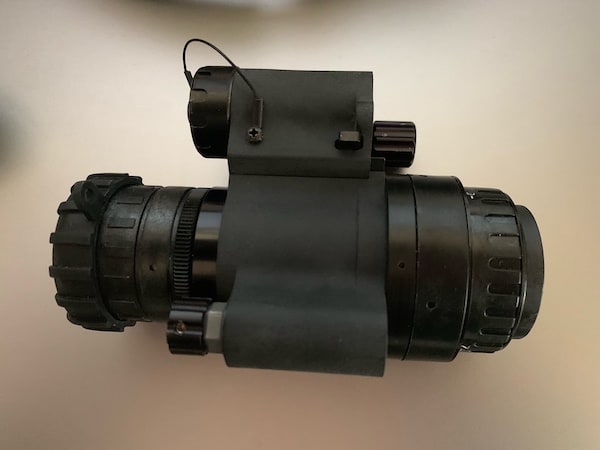
The Mod-3 is the most recommended regular NVD for astronomy. This is because it gives you the option of prime focus as well as manual gain control.
It is a monocular but two can be bridged together to make a binocular if you prefer to use two eyes handheld (or strapped to your head).
- Type: Monocular
- Lens interface: Standard or C-mount (afocal or prime)
- Gain control: Manual
- Green/White Phosphor: White or Green
PVS-7 Goggles
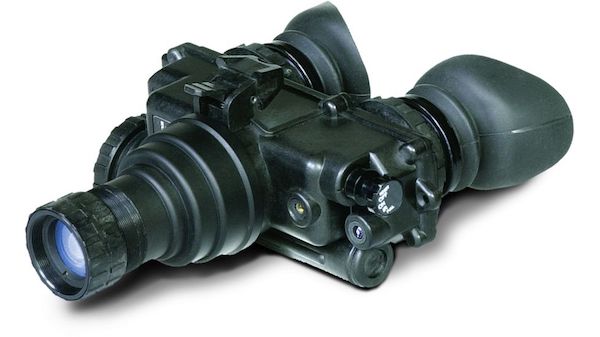
The PVS-7 housing has one image intensifier tube that splits the view into two eyepieces so that you can use both eyes. This is a particular advantage if you plan to use them handheld or attached to a helmet for scanning the sky.
The downside is no manual gain control.
- Type: Goggles
- Lens interface: C-mount or standard (afocal or prime)
- Gain control: Automatic only
- Green/White Phosphor: Green only
PVS-14 Monocular
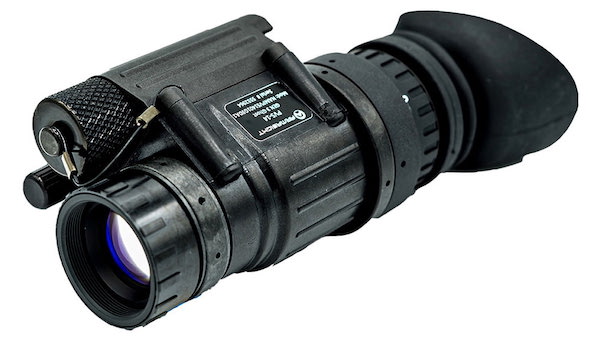
The PVS-14 night vision monocular is favored by some NVA enthusiasts.
It has adjustable gain, which is a positive over the PVS-7, however, it can only be used afocally and so some that plan to use it as part of a telescope setup might prefer the Mod-3 or the PVS-7.
- Type: Monocular
- Lens interface: Standard (Afocal only)
- Gain control: Manual
- Green/White Phosphor: White or Green
Digital Night Vision Devices for Astronomy
Slightly different from the above, digital NVDs do not incorporate an image intensifier.
They, therefore, do not offer the same level of performance, but they are worthy of mention since they are much cheaper.
SiOnyx Aurora
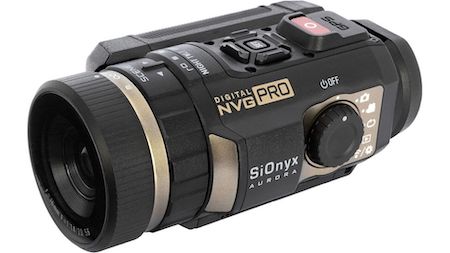
The most recommended digital night vision device for astronomy is the Sionyx Aurora.
There are a few different models:
- The original SiOnyx Aurora
- The SiOnyx Aurora Black – the same as the original above just without a built-in compass and GPS
- The SiOnyx Aurora Pro – the most advanced model with the best camera
A quick summary is that the Pro has the best camera for night vision, but the others are cheaper.
While these devices may not perform as well as an image intensified devices, they do have some advantages:
- Viewing is color, rather than white or green phosphor
- You can record video and timelapse movies with it
- It is substantially cheaper
In this screenshot from a video, you can see how a Sionyx Aurora Pro combined with a high powered lens versus an image intensified device and it’s pretty impressive (you can see the full video of this here):
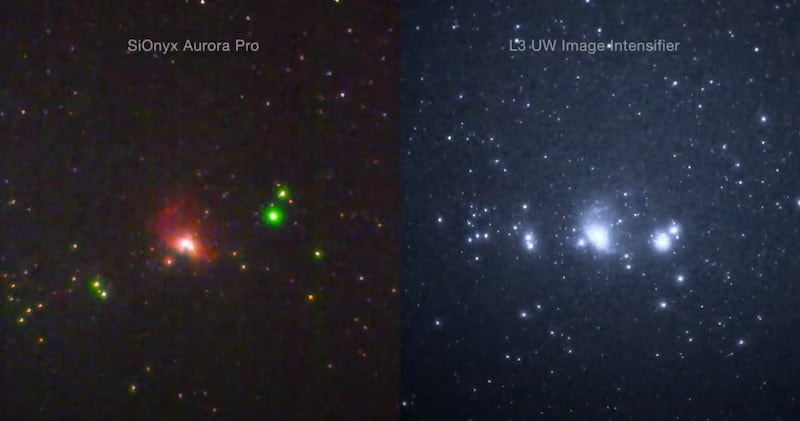
Where can you buy night vision devices for astronomy & astrophotography?
OVNI devices can be ordered directly from the company – see here.
The most commonly recommended outlets for buying regular NVDs for astronomy are these listed below:
By all accounts, it is recommended to get in contact with them and tell them you are looking for devices for astronomy use and they should be able to help point you in the right direction.
Note: we are not affiliated with any of these outlets nor do we receive anything for sending you there.
Night Vision Astronomy Accessories
In addition to the devices, there are a number of accessories that will aid the astronomy experience.
For handheld use, the main things are:
- Narrowband H-alpha filter: Will improve views of the night sky. Needs an adapter to hold it in place
- 3x afocal lens: Can be attached to the front of the device for 3x magnification
- C-mount to camera lens adapter: Allowing you to use regular (DLSR/mirrorless) camera lenses with your device
- Helmet or headstrap: So that you can look up handsfree if you so desire
- Smartphone adapter: To attach your phone for afocal photography
When using with a telescope, you may need:
- Afocal adapter: To connect the NVD to the eyepiece (Televue sell these, as well as OVNI for their devices)
- Eyepiece: The 55mm Televue 2-inch plossi is the most recommended.
- Filters: Longpass and h-alpha
- Baader coma corrector
Best telescopes for night vision astronomy
With regards to the telescope you use, a fast focal ratio is desirable and will produce the best results.
Most NVA enthusiasts prefer to use smaller refractors with fast focal ratios, rather than large reflectors.
Conclusion: Night Vision Astronomy – the future of astronomy or an expensive niche?
It’s hard not to be blown away by some of the images of what you can see and capture with night vision devices.
That, combined with the relative ease of use and at least partial answer to the light pollution problem, means that it seems likely that many more will take up this pursuit.
However, night vision devices are expensive and there are relatively few outlets dedicated to offering this gear specifically for astronomy. The argument that this cost can be offset by using cheaper telescopes is valid though and a NVA setup should well suit those living in cities who are faced with both light pollution and most probably the challenge of storing large traditional astronomy gear.
It’s great that at least one dedicated provider of night vision devices for astronomy (OVNI) has emerged in recent years and also that quality digital devices are offering a budget alternative. The question is will this trend continue and will we see more night vision devices for astronomy emerge?
We hope you found this interesting and useful. At the start, we found trying to understand NV astronomy pretty difficult. There are some good in-depth discussions on forums but these are often hard to follow for beginners.
If you have any questions about night vision astronomy or astrophotography please leave a comment below. See also more articles like this in our astronomy hub.
“The combination of real-time viewing and the simplicity of the platform made it an easy choice for me. It runs on just one double “A” battery too. Still on the one it came with! I’ve since sold off all my imaging gear as I don’t feel a need for it anymore. Not to say NV yields the high full color images of astrophotography. No way. But I’m spending more time looking at DSO’s instead of working on problems like polar alignments, laptops, software, guide cams, power generators and the rest.”
Dakota Starry Nights (YouTube, 2019)
Further information about Night Vision Astronomy
If you’d like more information about NVA then check out these links:
- Cloudy Nights Night Vision Astronomy forum
- Stargazers Lounge EEVA hub (covering NV and EAA)
- NV astronomer Peter Wang’s introduction to NVA
- Night Vision sub-Reddit (mostly military stuff, but some stargazing)
There are some other good YouTube channels to check out too:
- Carpe Nocturnum
- Jdb_astro
- The Night Vision Lab
- Mario Stroblmayr (in German, but you can view recordings he made with different NVDs, including OVNI devices more recently)


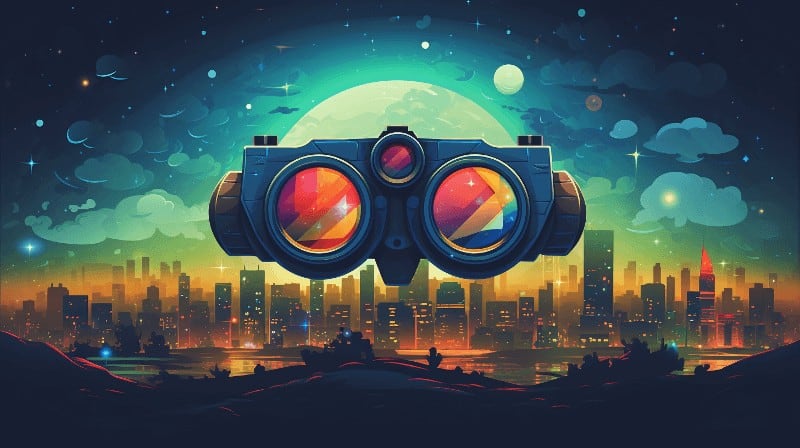

One thing I still don’t understand is whether one can use an image intensifier tube between a telescope and an astronomical camera (rather than just a phone) -and how one would insert it. Of course if one just wanted a photograph one could dispense with the i.i.t. and just do a long exposure. But I’m interested in live streaming (I use a Celestron 6SEon an AVX with a zwo 294 camera) and the quicker the image emerges the better, so in principle an i.i.t. could help. It sounds as though NVA could be a more practical approach than buying and operating a large Dob.
Hi Paul,
Sure you can. We sell the OVNI Camera Adapter for our OVNI-M & OVNI-B.
With this adapter you can attach any astronomical camera or DSLR.
See a tutorial video :
https://www.youtube.com/watch?v=yd67ykwbrUI
and
https://www.youtube.com/watch?v=dTG7uCHSACE
Do not hesitate to contact us if you have any question.
Kind regards,
www.ovni-nightvision.com